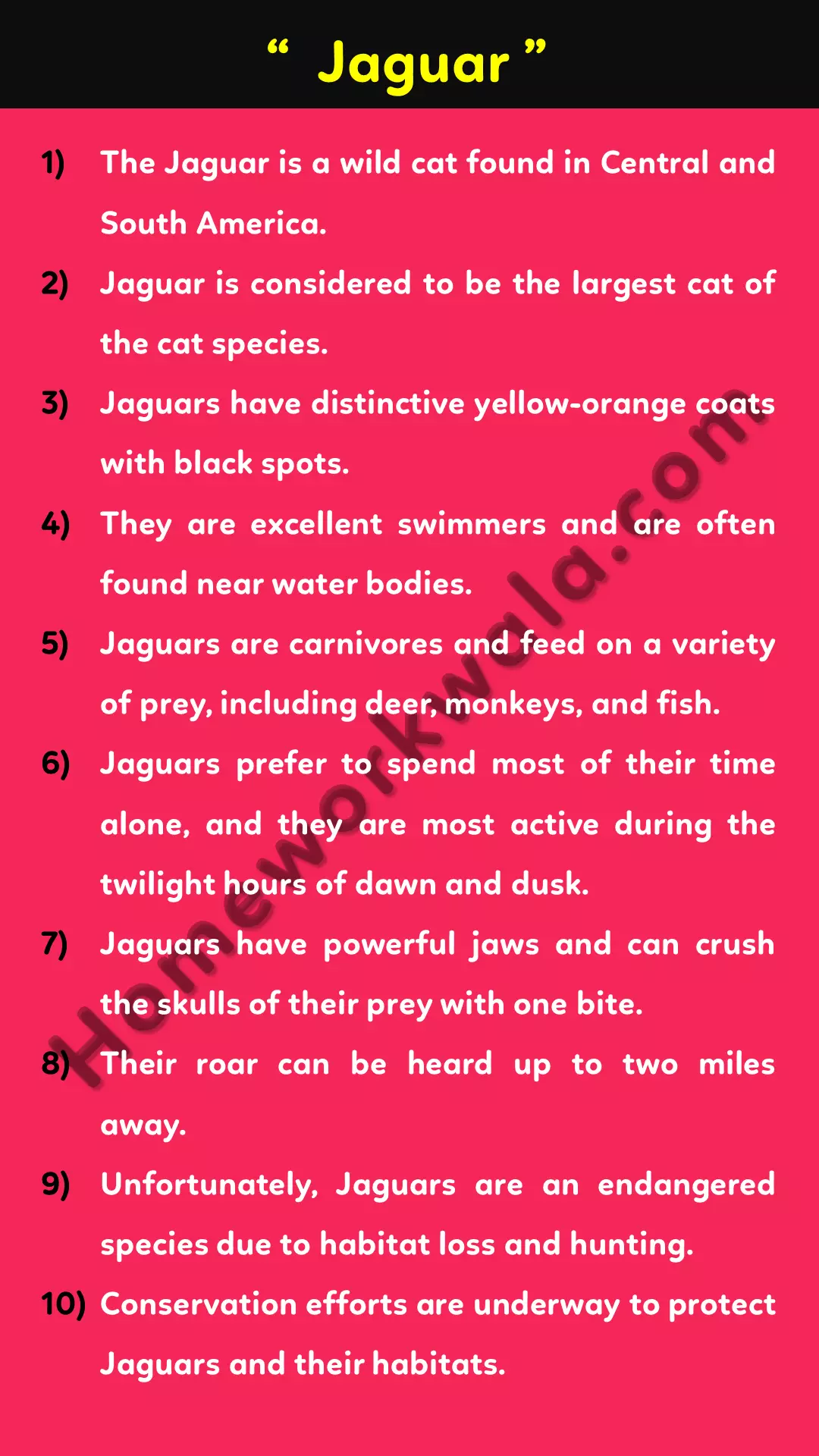Table of Content
Through this article, we are sharing 10 lines on Jaguar in English. This post will help those students who are looking for information about Jaguar in the English Language.
If any student wants to write a short essay on Jaguar then, this post is very useful for them. Information about Jaguar is very simple and easy for writing purposes.
These sentences on Jaguar are very short and easy to understand, so any level of student can write on this topic.

Short essay on Jaguar in English ( In 3 Formats )
Format-1
- The Jaguar is a wild cat found in Central and South America.
- Jaguar is considered to be the largest cat of the cat species.
- Jaguars have distinctive yellow-orange coats with black spots.
- They are excellent swimmers and are often found near water bodies.
- Jaguars are carnivores and feed on a variety of prey, including deer, monkeys, and fish.
- Jaguars prefer to spend most of their time alone, and they are most active during the twilight hours of dawn and dusk.
- Jaguars have powerful jaws and can crush the skulls of their prey with one bite.
- Their roar can be heard up to two miles away.
- Unfortunately, Jaguars are an endangered species due to habitat loss and hunting.
- Conservation efforts are underway to protect Jaguars and their habitats.
You May Also Like
Format-2
- Jaguars are very strong and agile animals, capable of climbing trees and running at high speeds.
- They have a keen sense of smell and hearing, which helps them locate their prey.
- Jaguars are important to their ecosystems as apex predators, helping to maintain a balance in the food chain.
- The Jaguar has a majestic scientific name that reflects its power and beauty known as Panthera onca.
- Jaguars have been featured in many indigenous cultures as symbols of power, strength, and protection.
- In some areas, Jaguars are known as “tigers,” but they are not related to the true tigers found in Asia.
- Jaguars communicate with each other through a variety of vocalizations, including growls, roars, and purrs.
- Female Jaguars give birth to 1-4 cubs, which they raise on their own.
- Jaguars have been known to live up to 20 years in captivity, but their lifespan in the wild is shorter due to threats from humans and other predators.
- Learning about Jaguars and their role in the ecosystem is an important part of conservation education.
Format-3
- Jaguars are excellent hunters, with strong legs and sharp claws that help them catch and kill their prey.
- They are also very good at hiding and stalking their prey before making their attack.
- The black coloration of some Jaguars is known as melanism, a genetic condition that causes an increase in dark pigmentation.
- The jaguar is the national animal of Guyana and is featured on the country’s coat of arms.
- In addition to their spotted coats, Jaguars also have unique patterns of rosettes (flower-shaped spots) on their fur.
- Jaguars are territorial animals, marking their boundaries with urine and feces.
- Humans are the biggest threat to Jaguar populations, as they are hunted for their fur and killed for attacking livestock.
- Jaguars are also threatened by habitat loss due to deforestation and development.
- In some indigenous cultures, Jaguars are revered as spiritual animals and are believed to possess special powers.
- By protecting Jaguars and their habitats, we can help ensure that these beautiful and important animals continue to thrive for future generations.

FAQ
- Where are Jaguars found?
- What do Jaguars eat?
- How big do the Jaguars get?
- How do Jaguars hunt?
- Are Jaguars endangered?
- How can we help protect Jaguars?
- What is the difference between a Jaguar and a leopard?
- Are Jaguars dangerous to humans?
Jaguars are found mainly in Central and South America, particularly in the Amazon rainforest.
Jaguars are carnivorous and feed on a variety of prey, including deer, monkeys, rodents, fish, and birds.
Jaguars are the largest cat species in the Americas and can weigh up to 300 pounds and grow up to 6 feet in length.
Jaguars are skilled hunters and use their powerful jaws and sharp teeth to deliver a deadly bite to their prey. They are also strong swimmers and can hunt fish and turtles in the water.
Yes, Jaguars are listed as a near-threatened species by the International Union for Conservation of Nature (IUCN) due to habitat loss, hunting, and other threats.
Protecting Jaguars and their habitats involves supporting conservation efforts, such as supporting organizations that work to preserve habitats, avoiding products that contribute to deforestation, and promoting responsible ecotourism practices.
While Jaguars and leopards share similar spotted coats, there are some key differences between the two species. Jaguars are larger and heavier than leopards, and their rosettes (flower-shaped spots) have dots inside them, while leopards do not.
Jaguars are generally not a threat to humans, but they can attack if they feel threatened or cornered. However, human activities such as hunting and habitat destruction pose a greater threat to Jaguars than the other way around.
We hope! You will get some learning through this article. If you really like this article about Jaguar in English, then please share it with your friends.
We working on helping the students to do their homework in a simple and easy way. Essay writing on Jaguar is generally asked the students in Schools.